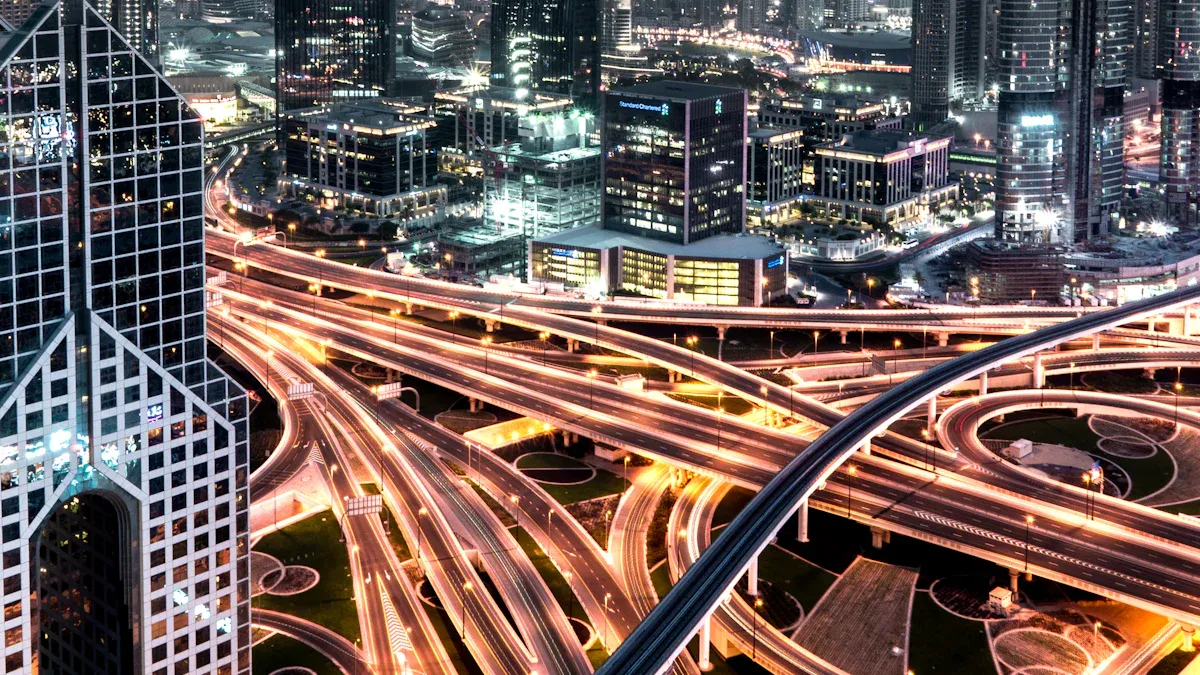
A smart city uses digital technologies to improve urban environments and solve challenges. You often see these cities addressing issues like public transportation, housing, and waste management. With rapid urbanization, nearly 70% of people will live in cities by 2050. This growth pushes governments to embrace smart city solutions powered by AI and data-driven tools.
Key Takeaways
-
Smart cities use tools like AI and IoT to make life better. These tools help with transport, saving energy, and being eco-friendly.
-
Cities such as Singapore and Zurich are top smart cities. They focus on new ideas and working with people to improve life.
-
Being eco-friendly is very important for smart cities. They work to cut pollution and clean the air for people and nature.
Singapore: The Top Smart City Globally
Smart Nation Initiative
Singapore’s Smart Nation Initiative has transformed it into a global leader among smart cities. This initiative focuses on leveraging technology to improve urban living and enhance public services. For example, all public housing developments in Singapore are now fully digitized. This digitization streamlines maintenance and management, ensuring better living conditions for residents. Additionally, smart meters for water and electricity allow you to monitor and manage consumption efficiently. Mobile apps further empower residents by enabling them to handle household services with ease.
Singapore’s consistent performance in global rankings highlights its success. It ranked #1 in the IMD Smart City Index for three consecutive years (2019–2021). These achievements reflect the city’s commitment to innovation and its ability to address urban challenges effectively.
AI-Driven Urban Management
AI plays a pivotal role in Singapore’s urban management systems. Traffic management powered by AI has significantly reduced congestion, saving the city an estimated $1 billion annually. Adaptive traffic signals have cut travel times by 30%, while incident response times have improved by 20%. These advancements not only enhance your daily commute but also contribute to sustainability by reducing carbon emissions by 15%, equivalent to 500,000 tons of CO2 annually.
Singapore’s AI systems also optimize infrastructure planning. By analyzing data from various sources, these systems help avoid costly expansions, saving $500 million in infrastructure costs. This approach demonstrates how AI can maximize resource utilization while improving urban living.
Sustainability and Urban Mobility
Singapore’s focus on sustainability and urban mobility sets it apart. The city became the first in the world to achieve full autonomous 5G network coverage in July 2022. This milestone enhances its Internet of Things (IoT) capabilities, which include intelligent traffic control and smart parking systems. In 2023, Singapore had 2.5 million IoT connections, a number projected to grow to 3.9 million by 2028. These technologies make your travel smoother and more efficient while reducing environmental impact.
By integrating AI and IoT, Singapore has also improved air quality. Levels of particulate matter (PM2.5) have decreased by 10%, benefiting both residents and the environment. These efforts highlight the city’s dedication to creating a sustainable and livable urban space.
Zurich: A Consistent Leader in Smart Cities
Smart City Index Achievements
Zurich consistently ranks as one of the top smart cities globally, showcasing its commitment to innovation and sustainability. For five consecutive years, it has secured the first position in the Smart City Index (SCI). In 2025, Zurich led the rankings again, followed by Oslo and Geneva. This recognition highlights Zurich’s ability to implement cutting-edge solutions that address urban challenges effectively.
Zurich’s achievements stem from its focus on integrating technology into urban planning and governance. These efforts have made it a benchmark for other cities aspiring to adopt smart city strategies.
Focus on Quality of Life
Zurich prioritizes improving your quality of life through sustainable and inclusive urban development. The city’s initiatives focus on reducing pollution, enhancing public transportation, and creating green spaces. By investing in renewable energy and efficient waste management systems, Zurich ensures a cleaner and healthier environment for its residents.
Public engagement also plays a key role. Zurich uses digital platforms to involve you in decision-making processes, fostering a sense of community and shared responsibility. These efforts make Zurich not just a smart city but also a livable one.
Technology-Driven Urban Solutions
Zurich’s success lies in its use of technology-driven urban development to address complex challenges. Geographic Information Systems (GIS) play a pivotal role in this transformation. These systems integrate spatial data to improve urban planning, resource management, and transportation efficiency.
|
Aspect of GIS Technology |
Contribution to Urban Solutions |
|---|---|
|
Data Integration |
Captures and manages spatial information for informed decision-making in urban planning. |
|
Community Engagement |
Visualizes data to engage residents in planning processes, leading to sustainable decisions. |
|
Resource Management |
Aids in efficient management of natural and human resources, promoting sustainability. |
|
Green Infrastructure |
Supports the design and implementation of projects that provide environmental benefits. |
|
Transportation Planning |
Enhances the efficiency of urban transportation systems, impacting overall sustainability. |
By leveraging these technologies, Zurich has created a model for sustainable and technology-driven urban development. Its approach ensures that you benefit from efficient services while contributing to a greener future.
Barcelona: A Pioneer in Smart Urban Infrastructure

IoT Integration in Public Services
Barcelona has embraced the Internet of Things (IoT) to revolutionize public services, making it a standout among smart cities. You can see this transformation in several areas:
-
Smart Waste Management: Sensors in waste bins notify workers when bins are full, reducing unnecessary collection trips and cutting emissions.
-
Energy-Efficient Street Lighting: Streetlights adjust brightness based on pedestrian activity, conserving energy while ensuring safety.
-
Smart Traffic Management: Real-time traffic monitoring and adjustments have significantly reduced congestion and emissions.
-
Smart Parking System: Sensors in parking spaces provide real-time availability updates, helping drivers find parking faster and easing traffic flow.
These IoT applications demonstrate how Barcelona uses technology to improve urban infrastructure and enhance sustainability.
Smart Lighting and Energy Efficiency
Barcelona’s smart lighting initiatives have set a benchmark in energy efficiency. The city has implemented connected streetlights equipped with LED retrofits and smart controls. These lights save over $37 million annually by reducing energy consumption. Beyond lighting, they gather data on foot traffic and air quality, enabling better urban planning. This dual-purpose approach optimizes city services and supports sustainability goals.
Urban Mobility Innovations
Barcelona has redefined urban mobility through innovative infrastructure. The city’s Digital Twins project creates virtual models of urban spaces. These models simulate the impact of new developments, helping planners design sustainable solutions. You can even participate by visualizing proposed changes and sharing feedback. This collaborative approach ensures that urban development aligns with community needs while prioritizing sustainability.
Copenhagen: A Sustainability-Focused Smart City

Green Energy and Climate Adaptation
Copenhagen has emerged as a global leader in green energy and climate adaptation. The city has transitioned from fossil fuels to renewable energy sources like wind, solar, and biomass. This shift has resulted in a 35% reduction in carbon emissions over the past decade. Strong government policies, financial incentives, and technological advancements have played a key role in this transformation.
You can see Copenhagen’s commitment to sustainability in its energy initiatives. The city prioritizes renewable energy adoption and integrates climate-resilient infrastructure into urban planning. These efforts not only reduce environmental impact but also ensure a cleaner, healthier living environment for residents.
Smart Biking Infrastructure
Copenhagen is often called the “City of Cyclists,” and for good reason. The city boasts 546 kilometers of bike lanes, making cycling a primary mode of transportation for 62% of its population. This extensive biking infrastructure reduces traffic congestion and promotes sustainable transportation.
The city also invests in innovative solutions to enhance the cycling experience. For instance, smart traffic signals prioritize cyclists during peak hours, ensuring smoother commutes. Campaigns like “Bike to Work” encourage more residents to adopt cycling, further reducing reliance on cars and lowering emissions.
Carbon Neutral Goals
Copenhagen aims to become the world’s first carbon-neutral capital by 2025. The city has made significant progress across various sectors:
|
Description |
|
|---|---|
|
Energy Transition |
Increasing renewable energy use and phasing out coal. |
|
Energy Efficiency |
Retrofitting buildings and promoting energy-efficient appliances. |
|
Sustainable Transportation |
Expanding cycling infrastructure and promoting electric vehicles. |
|
Waste Management |
Implementing advanced recycling and waste-to-energy systems. |
|
Green Spaces |
Increasing urban green spaces and promoting urban gardening. |
These initiatives demonstrate Copenhagen’s holistic approach to sustainability. By focusing on energy, transportation, and waste management, the city sets a benchmark for other smart cities striving for carbon neutrality.
Tokyo: A High-Tech Smart City in Asia
Intelligent Transportation Systems
Tokyo’s intelligent transportation systems set a global benchmark for efficiency and reliability. The city excels in urban mobility readiness and public transit performance, ranking 10th globally with a score of 64.2%.
|
Metric |
Rank |
Score |
|---|---|---|
|
Urban Mobility Readiness |
18 |
61% |
|
Sustainable Mobility |
24 |
57.5% |
|
Public Transit |
10 |
64.2% |
|
Technology Adoption |
21 |
49.2% |
Tokyo’s buses maintain a 0% early departure rate, ensuring punctuality. Despite a slight rise in road fatalities from 2023 to 2024, the city remains the safest in the Asia-Pacific region for road traffic. These achievements highlight Tokyo’s commitment to creating a smart city that prioritizes safety and efficiency.
Robotics and Disaster Management
Tokyo integrates robotics into disaster management to enhance urban resilience. The Takeshiba Project uses over a thousand sensors to collect urban data, which advanced modeling programs analyze. Emergency simulations with 3D city models predict congestion during crises, helping authorities plan effective responses. Pilot projects, such as robot delivery services, showcase Tokyo’s innovative use of technology to address urban challenges.
AI-Integrated Public Transport
AI has revolutionized Tokyo’s public transport systems. Before AI, operational errors and service interruptions were common. Now, predictive maintenance ensures smooth operations, and collision risks have significantly decreased.
|
Metric |
Before AI Implementation |
After AI Implementation |
|---|---|---|
|
Collision Risk |
High |
Significantly Reduced |
|
Operational Errors |
Frequent |
Minimal |
|
Service Interruptions |
Common |
Rare |
|
Predictive Maintenance |
Reactive |
Proactive |
These advancements make Tokyo’s public transport safer and more reliable, reinforcing its position as a leading smart city in Asia.
New York City: A Smart City in the United States
Data-Driven Governance
New York City has embraced data-driven governance to tackle urban challenges effectively. By partnering with HelioCampus, the city addressed issues like data leakage and siloed data sets. This collaboration led to the creation of a centralized data platform, improving decision-making and boosting confidence in data accuracy. To ensure transparency, a charter for data governance was established, outlining essential policies and procedures.
You can also benefit from initiatives like a data fluency course and a data dictionary, which enhance understanding and communication around data. Continuous evaluation of these processes ensures they remain adaptable and effective. These efforts highlight how New York City uses data to improve urban management and create a more efficient smart city.
Public Safety Innovations
New York City has made significant strides in public safety through innovative programs. The Crisis Management System’s Community Violence Intervention programs have reduced gun violence by 21% in targeted areas. This achievement translates to 1,567 fewer shootings between 2012 and 2024. These programs demonstrate the city’s commitment to creating safer neighborhoods for you and your community.
By integrating big data analytics, the city has also enhanced public safety measures. This approach improves real-time monitoring and emergency response, making New York City more resilient to challenges.
LinkNYC and Smart Traffic Management
LinkNYC kiosks have transformed public connectivity in New York City. These kiosks provide free Wi-Fi, phone calls, and device charging, ensuring you stay connected wherever you go. Beyond connectivity, the city has implemented smart traffic management systems to improve urban mobility. Big data analytics optimize traffic flow, reducing congestion and travel times.
Smart waste management systems further enhance sustainability by improving resource management and environmental outcomes. These innovations showcase New York City’s dedication to becoming a leading smart city.
Helsinki: A Smart City Focused on Public Safety
Smart Mobility Solutions
Helsinki has revolutionized urban transportation with its smart mobility solutions. The city’s Whim app integrates various transport modes, including buses, trains, taxis, and bike-sharing services. This seamless integration simplifies your travel experience and encourages the use of public transit. Over the years, public transit usage has increased by more than 15%, while urban traffic congestion has seen a significant reduction.
|
Metric |
Value |
|---|---|
|
Increase in public transit usage |
Over 15% |
|
Reduction in urban traffic congestion |
Significant |
These advancements highlight Helsinki’s commitment to creating a more efficient and user-friendly transportation system. By prioritizing mobility, the city ensures that you can navigate urban spaces with ease.
Green Urban Planning
Helsinki’s green urban planning initiatives aim to create a sustainable and eco-friendly environment. The city plans to increase green space coverage by 15% within the next five years. Additionally, 20 new urban wetlands will be developed to support amphibian populations and enhance biodiversity.
-
Helsinki’s Green City Plan includes ten cities, collectively housing 2.4 million people.
-
The plan focuses on biodiversity preservation and climate change mitigation.
-
About 50% of brownfield and agricultural areas could be converted for urban development.
These efforts not only improve the city’s environmental health but also provide you with more recreational spaces and cleaner air.
Citizen-Centric Innovations
Helsinki places you at the center of its smart city initiatives. The city uses digital platforms to involve residents in decision-making processes. For example, participatory budgeting allows you to vote on how public funds should be spent. This approach fosters a sense of community and ensures that urban development aligns with your needs.
By combining technology with public engagement, Helsinki creates a city that prioritizes your safety, convenience, and well-being. These innovations make it a global leader in citizen-focused urban planning.
San Francisco: The Smartest City of the Future
Silicon Valley’s Role in Innovation
San Francisco thrives as a hub of innovation, thanks to its proximity to Silicon Valley. The city boasts the highest concentration of AI and IoT companies in the nation, driving advancements in smart city technologies. With 39.72 tech jobs advertised per 1,000 jobs, the workforce reflects a strong focus on technology. You’ll find 70 coworking spaces fostering collaboration and remote work, along with 149 free Wi-Fi hotspots ensuring seamless connectivity.
|
Innovation Index |
Description |
|---|---|
|
Concentration of Tech Jobs |
San Francisco has 39.72 tech jobs advertised per 1,000 jobs, indicating a strong tech workforce. |
|
Presence of AI and IoT Companies |
The city has the highest concentration of AI and IoT companies in the nation, driving innovation. |
|
Electric Vehicle Promotion Actions |
42 actions promoting electric vehicles, including incentives and priority parking. |
|
Availability of Coworking Spaces |
70 coworking locations available, facilitating remote work and collaboration. |
|
Free Wi-Fi Hotspots |
149 free Wi-Fi hotspots ensure connectivity for residents and professionals. |
These factors position San Francisco as a leader in technological innovation, making it a fertile ground for startups like Anthropic and Perplexity AI.
Advanced Smart City Technologies
San Francisco’s smart city initiatives showcase cutting-edge technology. The Mission Bay Smart Street Experiment uses IoT and lidar sensors at intersections to track traffic, offering a scalable model for smart intersections. Cameras on Muni buses, powered by AI, have reduced transit lane violations by nearly 47%. The city’s automated speed camera program targets high-risk areas, with similar programs in other cities reducing speeding by over 70%.
|
Initiative |
Description |
Performance Outcome |
|---|---|---|
|
Mission Bay’s Smart Street Experiment |
IoT and lidar sensors installed at 10 intersections to track traffic. |
A promising blueprint for scaling smart intersections. |
|
Cameras on Buses |
AI-assisted cameras on Muni buses to catch transit lane violators. |
|
|
Automated Speed Camera Program |
AI-powered speed enforcement in high-risk areas approved in 2023. |
Similar programs in other cities saw speeding drop by over 70%. |
These advancements improve urban mobility and safety, making your daily commute more efficient and secure.
Vision for 2025
San Francisco’s vision for 2025 focuses on sustainability and innovation. The city aims to reduce CO2 emissions by 70% through its smart grid initiatives. AI-powered sorting systems will enhance recycling rates and minimize contamination, supporting the goal of zero waste to landfills by 2030.
-
San Francisco's smart grid aims to reduce CO2 emissions by 70%.
-
The city is working towards achieving zero waste to landfills by 2030.
-
AI-powered sorting systems are expected to improve recycling rates and reduce contamination.
With a young firm employment share of 13.3%, the city fosters a dynamic environment for startups. Companies like OpenAI and Anthropic lead AI innovation, occupying significant office space. As venture funding rebounds, San Francisco solidifies its position as a global leader in smart city development.
Smart cities integrate technology and innovation to create efficient urban environments. San Francisco’s forward-looking initiatives ensure it remains at the forefront of addressing urban challenges and enhancing livability.
Smart cities redefine urban living by integrating technology to address challenges and improve sustainability. AI and IoT enhance efficiency in areas like transportation and energy, reducing carbon footprints and boosting livability. These innovations align with global goals such as clean energy and infrastructure development, ensuring a healthier and more connected future for you.
FAQ
What is a smart city?
A smart city uses technology like AI and IoT to improve urban living. It enhances transportation, energy efficiency, and sustainability for better quality of life.
How do smart cities benefit you?
Smart cities reduce traffic, improve air quality, and enhance public services. They create safer, more sustainable environments for you to live and work.
Can smaller cities become smart cities?
Yes! Smaller cities can adopt scalable technologies like smart lighting, IoT sensors, and AI-driven systems to improve infrastructure and services efficiently.






